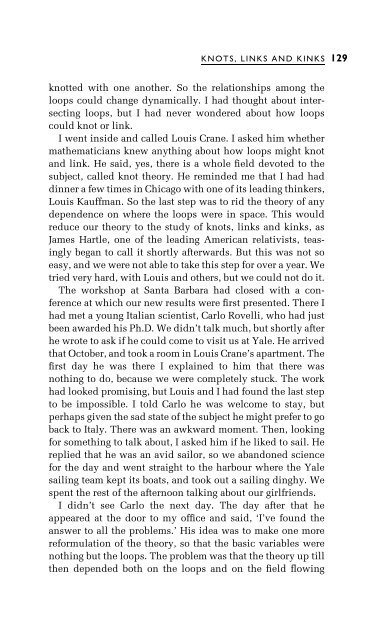Three Roads To Quantum Gravity
Three Roads To Quantum Gravity
Three Roads To Quantum Gravity
You also want an ePaper? Increase the reach of your titles
YUMPU automatically turns print PDFs into web optimized ePapers that Google loves.
KNOTS, LINKS AND KINKS<br />
129<br />
knotted with one another. So the relationships among the<br />
loops could change dynamically. I had thought about intersecting<br />
loops, but I had never wondered about how loops<br />
could knot or link.<br />
I went inside and called Louis Crane. I asked him whether<br />
mathematicians knew anything about how loops might knot<br />
and link. He said, yes, there is a whole ®eld devoted to the<br />
subject, called knot theory. He reminded me that I had had<br />
dinner a few times in Chicago with one of its leading thinkers,<br />
Louis Kauffman. So the last step was to rid the theory of any<br />
dependence on where the loops were in space. This would<br />
reduce our theory to the study of knots, links and kinks, as<br />
James Hartle, one of the leading American relativists, teasingly<br />
began to call it shortly afterwards. But this was not so<br />
easy, and we were not able to take this step for over a year. We<br />
tried very hard, with Louis and others, but we could not do it.<br />
The workshop at Santa Barbara had closed with a conference<br />
at which our new results were ®rst presented. There I<br />
had met a young Italian scientist, Carlo Rovelli, who had just<br />
been awarded his Ph.D. We didn't talk much, but shortly after<br />
he wrote to ask if he could come to visit us at Yale. He arrived<br />
that October, and took a room in Louis Crane's apartment. The<br />
®rst day he was there I explained to him that there was<br />
nothing to do, because we were completely stuck. The work<br />
had looked promising, but Louis and I had found the last step<br />
to be impossible. I told Carlo he was welcome to stay, but<br />
perhaps given the sad state of the subject he might prefer to go<br />
back to Italy. There was an awkward moment. Then, looking<br />
for something to talk about, I asked him if he liked to sail. He<br />
replied that he was an avid sailor, so we abandoned science<br />
for the day and went straight to the harbour where the Yale<br />
sailing team kept its boats, and took out a sailing dinghy. We<br />
spent the rest of the afternoon talking about our girlfriends.<br />
I didn't see Carlo the next day. The day after that he<br />
appeared at the door to my of®ce and said, `I've found the<br />
answer to all the problems.' His idea was to make one more<br />
reformulation of the theory, so that the basic variables were<br />
nothing but the loops. The problem was that the theory up till<br />
then depended both on the loops and on the ®eld ¯owing



![arXiv:1001.0993v1 [hep-ph] 6 Jan 2010](https://img.yumpu.com/51282177/1/190x245/arxiv10010993v1-hep-ph-6-jan-2010.jpg?quality=85)


![arXiv:1008.3907v2 [astro-ph.CO] 1 Nov 2011](https://img.yumpu.com/48909562/1/190x245/arxiv10083907v2-astro-phco-1-nov-2011.jpg?quality=85)








![arXiv:1002.4928v1 [gr-qc] 26 Feb 2010](https://img.yumpu.com/41209516/1/190x245/arxiv10024928v1-gr-qc-26-feb-2010.jpg?quality=85)
![arXiv:1206.2653v1 [astro-ph.CO] 12 Jun 2012](https://img.yumpu.com/39510078/1/190x245/arxiv12062653v1-astro-phco-12-jun-2012.jpg?quality=85)
